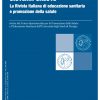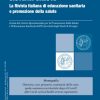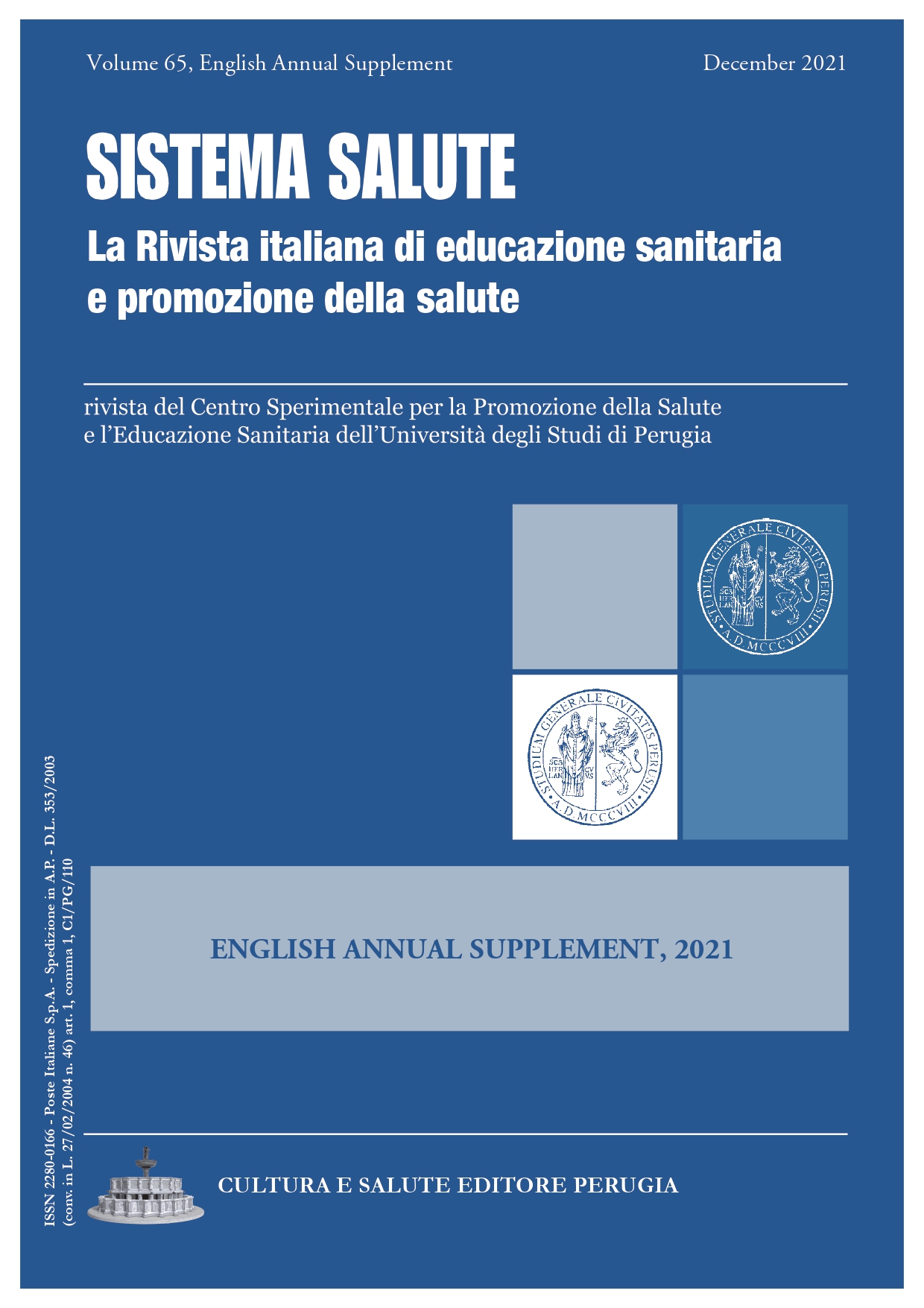Volume 65, English Annual Supplement December 2021
ONLINE OPEN ACCESS
Foreword – Sistema Salute experiments new editorial approaches
……..
Starting from the here briefly mentioned issues, we decided to diversify and en- rich our editorial approach by proposing to readers and experts of the subject some experiments providing a new articulation of Sistema Salute as it follows:
- an editorial space opening dedicated to health disputes(based on quality of solicited materials whether in the form of an annual dedicated issue either in form of a dedicated column in each issue);to document them, promote their knowledge, refine the arguments, allow them to be read across the board in order to enhance their impact and produce greater osmosis between the needs expressed by those exposed through them and the activities of services, local institutions and universities;
- greater interaction with the NHS, universities and local institutions aimed at stimulating production of texts on health promotion related issues;
- launch of an English annual issue which articles evaluated by the Editorial Committee, among those published in the last year, to be proposed to a global audience as they meet the criteria of methodological quality in text articulation, focused on general interest issues and with significant innovative elements in approach and proposal.
Indice
Milena Vainieri, Alice Borghini, Sabina Nuti
DOI: 10.48291/SISA.65.ensup.1
SCARICA IL PDF
DOI: 10.48291/SISA.65.ensup.1 Sistema Salute, 65, English Annual Supplement, 2021: pp. 8-21
Assessing the performance of the chronic care pathway
Milena Vainieri, Alice Borghini, Sabina Nuti
Laboratorio management e sanità, Istituto di Management, Scuola Superiore Sant’Anna di Pisa
Key words: chronic condition, performance, pathway, integration
SUMMARY
Objectives: value is a key point in a healthcare system, it can be detected through the implementation of performance measurement systems that evaluate the ability of organizations to take decisions and implement actions aim to create and provide value for the population. To reach this goal are needed performance representation tools that help to read health services in an integrated way. The aim of our paper is to describe the implementation into the performance measurement system adopted by 10 Ital- ian regions a new tool that can assess the value creation process across multiple healthcare organizations adopting the patient with chronic disease perspective.
Methods: the article describe the case study of introduction of a new representation tool for the assess- ment of the chronicity path: the stave.
Results: currently, the chronicity pathway includes 22 indicators grouped in 5 phases: prevention, com- pliance, efficiency, avoidable hospitalization and outcomes. The phase of compliance, related to primary care, is the one with the highest number of indicators, in line with the National Chronicity Plan. The two staves used as examples here show not only the path through the various phases but also the contribution of each provider (in this case group of general practitioners) to the performance of their geographic area.
Conclusions: the stave shows the performance of the care pathway through the patient’s perspective, overcoming providers boundaries and providing a common reading tool to the professionals involved. The stave is, like the performance measurement system, a dynamic system, in continuous revision and integration to meet the needs of the ever-changing healthcare system.
[ DIRECT URL ]
Carlo Romagnoli
DOI: 10.48291/SISA.65.ensup.2
SCARICA IL PDF
DOI: 10.48291/SISA.65.ensup.2 Sistema Salute, 65, English Annual Supplement, 2021: pp. 22-45
Proprietary logics, cognitive work, and corporate crisis
Carlo Romagnoli
Doctor specialized in Hygiene, Epidemiology and Public Health Expert in the organization, plan- ning, and evaluation of health servicesPresident of ISDE Umbria
Key words: corporatization, proprietary logics, professional organizations, knowledge economy, cognitive work
SUMMARY
Introduction: the impacts of the interaction between Covid 19 and the susceptible population present very marked inter- and intra-state spatial variations, leading to the emergence of the role of impact mod- ifier of national and regional health policies.
Objectives: the problem of examining these policies in depth is thus posed, seeking: a) via texts on so- ciology of organizations, the parameters of organizational planning in general and in health care, and the criteria that inspired, on the basis of the theory of the New Public Management, the corporatization of the SSN (Italian National Health Service); b) interpretations of critical economists who see in the growing role of the knowledge economy reasons for overcoming proprietary business logic.
Methods: on this basis, follows the analysis of the response which the SSN, as amended and also region- alized, gives to the complexity of the epidemiological situation, to inequalities in health care and access to services, to the corruptive phenomena in health care and to the presence in its services of cognitive workers endowed with wide professional autonomy.
Results: the powerful distorting role of proprietary logics emerges, inspired by the New Public Manage- ment that favors cuts in territorial services, privatization, and closure of participatory processes, with the effects of greater regional inequalities.
Particular problems emerge in the interactions with the cognitive work of health care workers, which cause conflicts with the ownership governance imposed with companies, deriving from the role of com- mon good of knowledge and its benefit from the sharing processes, proper to the scientific method. Conclusions: the hypothesis is developed for which current society, based on the knowledge economy, is positively affected by the conflict that cognitive work engages with proprietary logic, both by produc- ing common management methods suited to the specific characteristics of common knowledge, and therefore useful for redesigning health care, as well as effectively contrasting the neo-Darwinian and negationist logics particularly strong among Anglo-Saxon elites, as well as producing promising breaks in the asphyxiating real substation that characterized the last 30 years of the capitalist economy.
Corresponding author: Carlo Romagnoli surfcasting.dakhla@gmail.com
[ DIRECT URL ]
Guido Citoni, Domenico De Matteis, Margherita Giannoni
DOI: 10.48291/SISA.65.ensup.1
SCARICA IL PDF
DOI: 10.48291/SISA.65.ensup.3 Sistema Salute, 65, English Annual Supplement, 2021: pp. 46-62
Equity in the delivery and financing of health care and the SARS- COV-2 pandemic in Italy: where next?
Guido Citoni*, Domenico De Matteis**, Margherita Giannoni***
*Dipartimento di Medicina Molecolare Università La Sapienza ** Scuola di EconomiaUniversità La Sapienza
*** Dipartimento di EconomiaUniversità degli Studi di Perugia
Key words: equity in health and healthcare, Italy, Sars-Cov-2, healthcare financing SUMMARY
|
Introduction: the Italian National Health Service (SSN-ServizioSanitario Nazionale) is characterised by growing socioeconomic inequalities in health care use and financing. Over the years, these have increas- ingly translated into tangible violations of the equity principle, which characterises the SSN, based on the idea that the public health system, according to the Constitutional dictation (art.3) should guarantee equal access to care for citizens based on healthcare needs regardless of their ability to pay. |
|
Objectives: to discuss the main Italian evidence available concerning income-related equity in the use (horizontal) and the financing (vertical)of healthcare services from a health economics perspective; to describe the main challenges posed by the SARS-COV-2 pandemic. |
|
Methods: the main evidence for Italy from the economic literature on the measurement of both horizon- tal and vertical equity is discussed and recent trends in healthcare expenditure are reported before and during the SARS-COV-2 pandemic. |
| Corresponding author: Margherita Giannoni (margherita.giannoni@unipg.it) |
[ DIRECT URL ]
Carlo Romagnoli, Anna Rita Guarducci, Fabio Neri, Lucio Pala, Giovanni Vantaggi
DOI: 10.48291/SISA.65.ensup.4
SCARICA IL PDF
DOI: 10.48291/SISA.65.ensup.4 Sistema Salute, 65, English Annual Supplement, 2021: pp. 63-83
Sharing and developing a Model for Primary Territorial Prevention: the Ecodistrict
Carlo Romagnoli 1, Anna Rita Guarducci 2, Fabio Neri 3 , Lucio Pala 4, Giovanni Vantaggi 5
1 Doctor specialized in Hygiene, Public Health and Epidemiology; Regional President at Umbria ISDE – Italy
2Anna Rita Guarducci, Eco-architect, Coordinator at Zero Waste Regional Coordination Umbria 3 Fabio Neri, Sociologist, Chairman at Committee No Incinerators Terni 4 Lucio Pala, Teacher, President at Borgoglione Observatory (Perugia) 5 Giovanni Vantaggi, Doctor, Provincial President at ISDE – Italy, Perugia
Key words: models for primary prevention, environmental determinants of health, reappropriation of environmental matrices, common management, negative externalities of environmental pollution
SUMMARY
Introduction: the Models of Primary Territorial Prevention (MPTP) and environmental legislation in force do not protect environmental matrices (air, water, soil) from linear productive activities that do not separate the technical and biological cycles. Hence, they introduce pollutants that increase disease risk, alter and subtract the matrices from the common uses of the inhabitants and damage the homeostasis of ecosystems and habitat of other species.
Objectives: activate a shared process for defining and experimenting a MPTP that:
a) safeguards environmental matrices from pathogenic and unsafe uses;
b) rebalances the related power asymmetries;
c) has positive impacts on health, environment, the economy and territorial management.
Materials and methods: Creation of meaning, meta-organization, investigation/with research, are used to activate a process of shared development of a MPTP which include territorial committees of the involuntarily exposed, environmental associations and local authorities as well as motivate present social knowledge to participate in the enrichment of the model.
Results: A first set of results concerns:
1) shared conceptual bases (systemic approach, circular economy, criteria for effective management of the commons) and 1.2) analysis of processes connected with linear production activities (risk production, disposals and negative externalities) that base nominations (risk producers, involuntarily exposed) more suited to the real impacts produced and 1.3) the constitutive characteristics of a MPTP capable of preventing them, the ecodistrict;
2) a second group of results documents 2.1) application developments (first activation of the ecodistricts 65 in defined territories, law proposal for the ecodistrict, audit characteristics on the state of the matrices); 2.2) potential emerging obstacles and 2.3) implementations in place.
Discussion and conclusions: concern the methods aspects connected with the sharing processes and the impact of the ecodistrict MPTP on health, environment and economy/management of the territories.
Corresponding author: Carlo Romagnoli surfcasting.dakhla@gmail.com
[ DIRECT URL ]
Massimo Formica
DOI: 10.48291/SISA.65.ensup.5
SCARICA IL PDF
DOI: 10.48291/SISA.65.ensup.5 Sistema Salute, 65, English Annual Supplement, 2021: pp. 84-112
The Organic District: a cultural turning point
Massimo Formica
ISDE International Society of Doctors for the Environment
Key Words: soil, microbiome, epigenetics, nutritional quality
SUMMARY
Objectives: this article aims to show how an erroneous concept of agriculture based on a proto-scientific knowledge of the sixties, founded on chemical synthesis and forced mechanization, has been crushed by the knowledge we have since gained but which seems to have been culpably concealed and/or underrated in terms of ecosystems and of its implications on the basis of epigenetic, biomolecular analyses. The de- layed discovery of 1. the need to measure ourselves with a closed system of reference 2. the dependence, even genomic, on an invisible and omni pervasive microbiota 3. the reliance on a fluid genome that duly registers epigenetically within us the outside world 4. the need to give value to, to emphasize and protect the integrity of our natural air-water-soil matrices. All existential preconditions which oblige us to totally reframe the mechanistic, linear algorithms that pervade the present, but which prove to be anachronistic and unscientific.
Methods: the available data invoking a change in paradigm has been taken into consideration. The start- ing point is the orientation and the logic inspiring the European Community’s legislation on organic districts.
Results: a case is made for the interconnectivity that inhabits us, the relationship between the context and the genetic-epigenetic-microbiome triad, the imperative to substitute an epistemic of predictability which is fallacious on account of the reductive variables considered, the hyper complexity of the infinite variables in a biological system based on creativity and autopoiesis, on serial and interim adaptations in dynamic evolution. The results speak unequivocally of a necessary and rapid conversion to agroecology to avoid the definitive destruction of our matrix that would lead to an unamendable process of mul- tispecies extinction.
Conclusions: there is evidence beyond any reasonable doubt of the need for a rapid assumption of politi- cal ethics and leadership to control and marginalize the risk producers, to reestablish the right to health, environmental and food quality and furthermore beauty itself as a nutritional element. All in the greatest respect possible for biodiversity and all the creatures and things with which we share a common destiny.
Corresponding author: Massimo Formica maxsusant@gmail.com
[ DIRECT URL ]
Francesco Masciarelli
DOI: 10.48291/SISA.65.ensup.6
SCARICA IL PDF
DOI: 10.48291/SISA.65.ensup.6
Systemic and participatory design of socio-ecological and territorial matrices as an interface between human and environmental systems: the (possible) role of an eco-district
Francesco Masciarelli
Architect and independent researcher, Perugia, Italy
Key words: sustainable resilient urban planning; eco-district systemic design; territory-interface;
ecological systems
SUMMARY
Problems addressed: the crises of the natural environment and territory are systemic, environmental and social. Indeed, they are socio-ecological systems (SESs), that is, systems in which ‘the social, economic, ecological, cultural, political, technological and other components are strongly linked … emphasizing the integrated concept of the human-in-nature perspective’. These are deeply interconnected and co-evolu- tive systems, in which the ‘ecological component provides essential services to society’. The integrated character of SESs makes the environmental perspective inseparable from the social one and mutually conditioned. Indeed, the approach by which to study, design and govern the natural environment and territory is instead ‘culturally’ based on the ‘values of modernity’ and, so far, directed to the exploitation of the natural and human environment in order to seek profits and economic development. In order to be successfully implemented, such exploitation requires processes and tools that can guarantee human beings’ distancing and separation from each other and from nature.
Objectives: this research starts from the assumed need for a review of the ‘values of modernity’ and believes it must question the ways and means through which these values ‘create’ or modify the SESs we call the natural environment and territory.
Methods: after an examination of innovative and alternative models of design and governance of territory, I believe we can identify in systemic design based on the eco-district concept (eco-district-systemic-design, EDSD) a systemic and participatory tool for a sustainable and resilient requalification of the socio-ecological matrices of the natural environment and territory.
Results: in our model, the eco-district, as a model for territorial primary prevention (MTPP), becomes a structuring element of ‘the organization of a territorial cognitive framework, which contains, organises and makes transmissible all the elements that make up the complex urban and territorial space’. Territory is regarded here as an interface between physical-environmental (natural and human-modified) systems and social systems and sustainability integrated by the concept of resilience, while linear economy becomes circular. Training, information and participation processes in decision making and the planning
Corresponding author: info@architettomasciarelli.com
[ DIRECT URL ]
.





